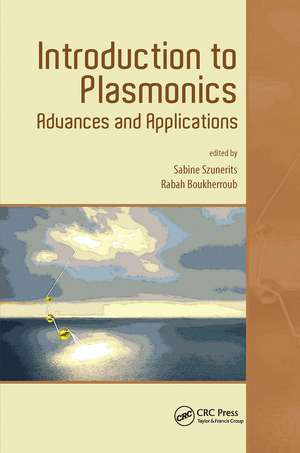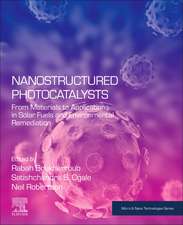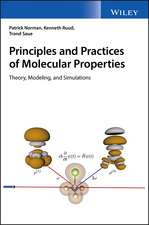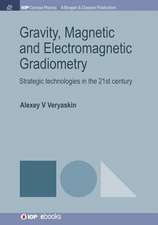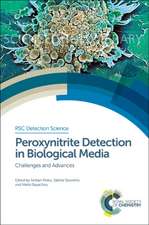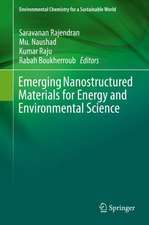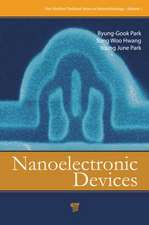Introduction to Plasmonics: Advances and Applications
Editat de Sabine Szunerits, Rabah Boukherrouben Limba Engleză Hardback – 24 mar 2015
Preț: 898.29 lei
Preț vechi: 1095.47 lei
-18% Nou
Puncte Express: 1347
Preț estimativ în valută:
171.94€ • 186.83$ • 144.52£
171.94€ • 186.83$ • 144.52£
Carte tipărită la comandă
Livrare economică 21 aprilie-05 mai
Preluare comenzi: 021 569.72.76
Specificații
ISBN-13: 9789814613125
ISBN-10: 9814613126
Pagini: 378
Ilustrații: 123 black & white illustrations, 18 colour illustrations
Dimensiuni: 152 x 229 x 25 mm
Greutate: 0.65 kg
Ediția:1
Editura: Jenny Stanford Publishing
Colecția Jenny Stanford Publishing
ISBN-10: 9814613126
Pagini: 378
Ilustrații: 123 black & white illustrations, 18 colour illustrations
Dimensiuni: 152 x 229 x 25 mm
Greutate: 0.65 kg
Ediția:1
Editura: Jenny Stanford Publishing
Colecția Jenny Stanford Publishing
Public țintă
Academic and PostgraduateCuprins
Preface. Foreword by Wolfgang Knoll. Propagating Surface Plasmon Resonance. Different Strategies for Glycan Immobilization onto Plasmonic Interfaces. Biophysics of DNA: DNA Melting Curve Analysis with Surface Plasmon Resonance imaging. Plasmon waveguide resonance spectroscopy: principles and applications in studies of molecular interactions within membranes. Surface-Wave Enhanced Biosensing. Infrared Surface Plasmon Resonance. The Unique Characteristics of Localized Surface Plasmon Resonance. Advances in the Fabrication of Plasmonic Nanostructures: Plasmonics Going Down to Nanoscale. Colorimetric Sensing Based on Metallic Nanostructures. Surface-Enhanced Raman scattering (SERS): Principles and Applications for Single-Molecule Detection. Graphene-Based Plasmonics. SPR: An Industrial Point of View.
Notă biografică
Sabine Szunerits is professor of chemistry at the Université de Lille 1, France, and was nominated in 2011 a member of the Institut Universitaire de France. Her current research interests are in the area of materials science with emphasis on the development of novel analytical platforms and interfaces for the study of affinity binding events and in the modification of nanostructures (diamond particles, magnetic particles, and nanographene) for biomedical applications. She is a co-author of more than 186 research publications, has written several book chapters, and has 6 patents to her credit.
Rabah Boukherroub is a director of research at the CNRS, France, and a group leader at the Institute of Electronics, Microelectronics and Nanotechnology, Université de Lille 1. His research interests are in the area of synthesis of functional nanomaterials (metal and semiconductor nanoparticles, semiconductor nanowires, graphene, carbon nanodots, etc.), surface chemistry, and photophysics of semiconductor/metal nanostructures with emphasis on biosensors and lab-on-chip applications, drug delivery, and development of new tools for studying molecular dynamics in vivo. He is a co-author of more than 310 research publications and has written 22 book chapters in subjects related to nanotechnology, materials chemistry, and biosensors. He has 9 patents or patents pending.
Rabah Boukherroub is a director of research at the CNRS, France, and a group leader at the Institute of Electronics, Microelectronics and Nanotechnology, Université de Lille 1. His research interests are in the area of synthesis of functional nanomaterials (metal and semiconductor nanoparticles, semiconductor nanowires, graphene, carbon nanodots, etc.), surface chemistry, and photophysics of semiconductor/metal nanostructures with emphasis on biosensors and lab-on-chip applications, drug delivery, and development of new tools for studying molecular dynamics in vivo. He is a co-author of more than 310 research publications and has written 22 book chapters in subjects related to nanotechnology, materials chemistry, and biosensors. He has 9 patents or patents pending.
Descriere
Plasmonics is a highly dynamic field, and a number of researchers and scientists from other disciplines have become involved in it. This book presents the most widely employed approaches to plasmonics and the numerous applications associated with it. There are several underlying elements in plasmonics research. Advances in nanoscience and nanotechnology have made possible the fabrication of plasmonic nanostructures, deposition of thin films, and development of highly sensitive optical characterization techniques. The different approaches to nanostructuring metals have led to a wealth of interesting optical properties and functionality via manipulation of the plasmon modes that such structures support. The sensitivity of plasmonic structures to the changes in their local dielectric environment has led to the development of new sensing strategies and systems for chemical analysis and identification. The book discusses all of these aspects.
